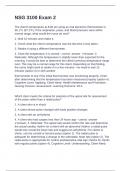-
1. Exam (elaborations) - Aurora university question and answers verified to pass
-
2. Exam (elaborations) - Chapter 35 nursing 3100 question and answers correctly solved
-
3. Exam (elaborations) - Chapter 36 nursing 3100 questions with complete solution
-
4. Exam (elaborations) - Chapter 37 nursing 3100 question and answers rated a+
-
5. Exam (elaborations) - Exam 4 nsg 3100 question and answers verified to pass
-
6. Exam (elaborations) - Exam 4 nsg 3100 question and answers correctly solved
-
7. Exam (elaborations) - Exam 22 question and answers verified to pass
-
8. Exam (elaborations) - Galen nsg 3100 exam 1 question and answers rated a+
-
9. Exam (elaborations) - Galen nsg 3100 question and answers rated a+
-
10. Exam (elaborations) - Module 2 question and answers 100% correct
-
11. Exam (elaborations) - Nrsg 3100 exam 1 question and answers already passed
-
12. Exam (elaborations) - Nrsg 3100 exam 2 meds question and answers verified to pass
-
13. Exam (elaborations) - Nrsg 3100 exam question and answers correctly solved
-
14. Exam (elaborations) - Nrsg 3100 exam questions with complete solution
-
15. Exam (elaborations) - Nrsg 3100 test 3 question and answers rated a+
-
16. Exam (elaborations) - Nrsg 3100 unit 1 question and answers rated a+
-
17. Exam (elaborations) - Nrsg 3100 unit 4 question and answers 100% correct
-
18. Exam (elaborations) - Nrsg 3100 unit 9 question and answers already passed
-
19. Exam (elaborations) - Nrsg 3100 units 10 question and answers correctly solved
-
20. Exam (elaborations) - Nrsg 3100 questions with complete solution
-
21. Exam (elaborations) - Nsg 3100 question and answers already passed
-
22. Exam (elaborations) - Nsg 3100 question and answers verified to pass
-
23. Exam (elaborations) - Nsg 3100 questions with complete solution
-
24. Exam (elaborations) - Nsg 3100 question and answers rated a+
-
25. Exam (elaborations) - Nsg 3100 question and answers already passed
-
26. Exam (elaborations) - Nsg 3100 question and answers verified to pass
-
27. Exam (elaborations) - Nsg 3100 exam 2 questions with complete solution
-
28. Exam (elaborations) - Nsg 3100 exam 2 questions with complete solution
-
29. Exam (elaborations) - Nsg 3100 exam 3 question and answers rated a+
-
30. Exam (elaborations) - Nsg 3100 exam 3 question and answers already passed
-
31. Exam (elaborations) - Nsg 3100 exam 3 question and answers verified to pass
-
32. Exam (elaborations) - Nsg 3100 exam 3 question and answers correctly solved
-
33. Exam (elaborations) - Nsg 3100 exam 3 question and answers rated a+
-
34. Exam (elaborations) - Nsg 3100 exam 4 question and answers 100% correct
-
35. Exam (elaborations) - Nsg 3100 exam question and answers already passed
-
36. Exam (elaborations) - Nsg 3100 unit 1 question and answers already passed
-
37. Exam (elaborations) - Nsg 3100 unit 10 fluids questions with complete solution
-
38. Exam (elaborations) - Nsg 3100 vital signs question and answers rated a+
-
39. Exam (elaborations) - Nsg 3100 wounds question and answers 100% correct
-
40. Exam (elaborations) - Nsg 3100 question and answers already passed
-
41. Exam (elaborations) - Nsg question and answers verified to pass
-
42. Exam (elaborations) - Nsg3100 exam 4 practice questions and answers correctly solved
-
43. Exam (elaborations) - Nur 215 exam 1 practice arizona college questions verified to pass
-
44. Exam (elaborations) - Nur 3100 exam 1 question and answers rated a+
-
45. Exam (elaborations) - Nurs 209 exam 1 study question and answers verified to pass
-
46. Exam (elaborations) - Nurs 3100 question and answers verified to pass
-
47. Exam (elaborations) - Nurs 3100 question and answers verified to pass
-
48. Exam (elaborations) - Nurs 3100 exam 1 material question and answers correctly solved
-
49. Exam (elaborations) - Nurs 3100 exam 1 questions with complete solution
-
50. Exam (elaborations) - Nurs 3100 final exam module questions and answers 100% correct
-
51. Exam (elaborations) - Nurs 3100 final exam review question and answers verified to pass
-
52. Exam (elaborations) - Nurs 3100 mylab question and answers correctly solved
-
53. Exam (elaborations) - Nurs 3100 question and answers 100% correct
-
54. Exam (elaborations) - Nursing 3100 question and answers verified to pass
-
55. Exam (elaborations) - Nursing 3100 exam 3 question and answers rated a+
-
56. Exam (elaborations) - Nursing 3100 exam question and answers already passed
-
57. Exam (elaborations) - Nursing 3100 final exam question verified to pass
-
58. Exam (elaborations) - Nutrition 3100 ch question and answers correctly solved
-
59. Exam (elaborations) - Pharmacology 3100 final questions with complete solution
-
60. Exam (elaborations) - Success in practical question and answers rated a+
-
Show more




